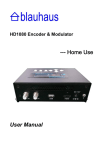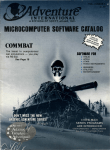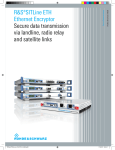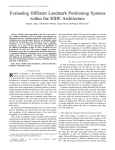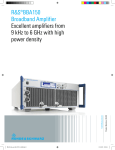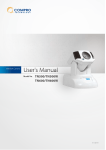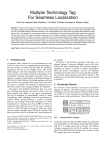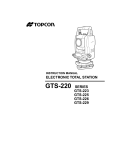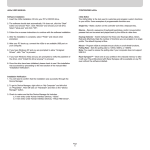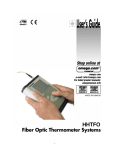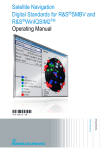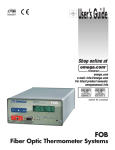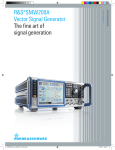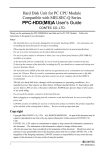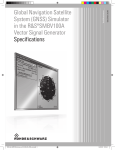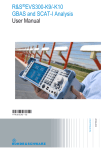Download Product Brochure (english) für GNSS Simulator
Transcript
GNSS_Simulator_in_the_SMBV100A_bro_en_5214-5284-12_v0600.indd 1 Product Brochure | 06.00 Test & Measurement GNSS Simulator in the R&S®SMBV100A Vector Signal Generator The new reference in satellite simulation 10.09.2015 13:41:02 GNSS Simulator in the R&S®SMBV100A At a glance Whether in the R & D lab or in production, the global navigation satellite system (GNSS) solution for the R&S®SMBV100A sets new standards in the field of satellite simulation. It supports all possible scenarios, from simple setups with static satellites all the way to flexible scenarios generated in realtime with up to 24 dynamic GPS, Glonass, Galileo, BeiDou and QZSS/SBAS satellites. A number of standard tests are available for characterizing the performance of a GNSS receiver, e.g. time to first fix (TTFF) and location accuracy. Test runs often include an entire series of tests, each with a different scenario. Therefore, satellite simulators that allow users to simulate a wide variety of scenarios are ideal for this purpose. This is where the flexibility of the GNSS solution for the R&S®SMBV100A stands out: Only a few keystrokes are needed to generate complex scenarios, unlimited in time, with up to 24 satellites – including hybrid GPS, Glonass, Galileo, BeiDou and QZSS/SBAS constellations. Users can select the almanac file as well as the geographic position, and both stationary positions and moving scenarios that simulate the movement of receivers along any custom route are possible. The signal strength of individual satellites can be controlled in realtime in order to simulate conditions of restricted satellite visibility. The GNSS functionality provided by the R&S®SMBV100A also includes the ability to simulate realistic transmission and signal reception conditions through the use of multipath signal generation, by modeling various a tmospheric effects and surroundings with buildings and bridges, or by simulating realistic vehicle dynamics. The versatility of the R&S®SMBV100A is especially beneficial to mobile phone and car infotainment system manufacturers who integrate GNSS modules in their products, as it allows them to test a range of functions with a single instrument. This is possible because, in addition to GNSS signals, the R&S®SMBV100A also generates communications signals conforming to all conventional standards such as LTE, HSPA+ and WiMAX™ as well as signals for digital radio standards such as DAB, XM Radio or Sirius. Key facts ❙❙ Support of GPS L1/L2 (C/A and P code), Glonass L1/L2, Galileo E1, BeiDou B1/B2 and QZSS/SBAS L1, including hybrid constellations ❙❙ Realtime simulation of realistic constellations with up to 24 satellites and unlimited simulation time ❙❙ Flexible scenario generation including moving scenarios, dynamic power control and atmospheric modeling ❙❙ Configuration of realistic user environments, including obscuration and multipath, antenna characteristics and vehicle attitude ❙❙ Static mode for basic receiver testing using signals with zero or constant Doppler shift ❙❙ Support of Assisted GNSS (A-GNSS) test scenarios, including generation of assistance data for GPS, Glonass, Galileo, BeiDou and QZSS/SBAS ❙❙ Realtime external trajectory feed for hardware in the loop (HIL) applications ❙❙ Logging of simulation data ❙❙ High signal dynamics 1), simulation of spinning vehicles and precision code (P code) simulations to support aerospace and defense applications ❙❙ Enhanced simulation capabilities for aerospace applications by supporting ground-based augmentation systems (GBAS) ❙❙ Support of other digital communications and radio standards in the same instrument May be subject to export restrictions. 1) 2 GNSS_Simulator_in_the_SMBV100A_bro_en_5214-5284-12_v0600.indd 2 10.09.2015 13:41:02 GNSS Simulator in the R&S®SMBV100A Benefits and key features GNSS receiver tests made easy ❙❙ Flexible scenario generation facilitates receiver testing ❙❙ Faster testing with GNSS signal generation in realtime ❙❙ Static simulations with zero or constant Doppler shifts for rapid receiver prototyping and development ❙❙ Unlimited simulation time with automatic, o n-the-fly exchange of satellites ❙❙ Support of Assisted GNSS (A-GNSS) test cases for GPS, Glonass, Galileo, BeiDou and QZSS/SBAS ❙❙ Aerospace and defense applications ❙❙ Support of hardware-in-the-loop applications through realtime external trajectory feed ▷▷ page 4 Simulation of real-world conditions ❙❙ Ensuring realistic conditions for receiver tests ❙❙ Simulation of atmospheric effects ❙❙ Customizable antenna characteristics ❙❙ Realistic vehicle dynamics, including attitude simulation ❙❙ Urban canyon simulations with multipath and signal obscuration ❙❙ Customizable land mobile multipath environment ❙❙ Configurable noise and interference simulation ▷▷ page 8 Customized solutions through flexible options ❙❙ Instrument configuration tailored to customer needs ❙❙ Ready for other GNSS standards ❙❙ Ideal for production and R & D alike ▷▷ page 11 GNSS simulation plus multifaceted vector signal generation ❙❙ Support of all important, state-of-the-art digital standards ❙❙ Customized internal signal generation ❙❙ High performance for all types of applications ▷▷ page 12 Simulation of a combined GPS/Glonass/Galileo/BeiDou/QZSS constellation with consideration of signal obscuration and multipath. GNSS_Simulator_in_the_SMBV100A_bro_en_5214-5284-12_v0600.indd 3 Rohde & Schwarz GNSS Simulator in the R&S®SMBV100A Vector Signal Generator 3 10.09.2015 13:41:02 GNSS receiver tests made easy Whether measuring TTFF, location accuracy, reacquisition time or sensitivity: With the GNSS simulator solution in the R&S®SMBV100A, the performance of receivers is quickly and easily characterized. Flexible scenario generation facilitates receiver testing A number of standard tests are available for characterizing the performance of a GNSS receiver, including TTFF, location accuracy and sensitivity tests. Entire test series are usually required before statistically solid statements can be made about the characteristics of a receiver. Each test in the series can be based on a different scenario, i.e. different conditions under which the test takes place. For example, the number of visible satellites or the satellite signal strength can be varied in order to simulate scenarios where satellite visibility is restricted. Even the geographic position can be changed from test to test. While one scenario is based on a stationary position, another might be based on moving along a defined route (moving scenario). Many GNSS simulators offer users only a defined number of precalculated scenarios for playback. But this usually does not meet the requirements and conditions described above. In contrast, the R&S®SMBV100A allows users to generate unlimited customized scenarios, making it easy to perform receiver tests under varying conditions. Only a few keystrokes are needed in the R&S®SMBV100A user interface to generate complex scenarios with up to 24 satellites. Multistandard GNSS receivers are constantly increasing in importance. This is why the R&S®SMBV100A was designed to simultaneously generate GPS, Glonass, Galileo, BeiDou and QZSS/SBAS signals in hybrid constellations. The R&S®SMBV100A simulates the movement of satellites in orbits according to a real almanac file c ontaining real navigation data. Any SEM or YUMA almanac file can be loaded into the R&S®SMBV100A for this purpose. The user can define any start time or date as well as any geographic position for either a stationary or a moving scenario. A moving scenario can be defined as any route, such as a drive through downtown Rome. The path trajectory is specified either with a simple waypoint file or by importing NMEA files. The R&S®SMBV100A generates hybrid GPS, Glonass, Galileo, BeiDou and QZSS satellite constellations with minimum position dilution of precision (PDOP). 4 GNSS_Simulator_in_the_SMBV100A_bro_en_5214-5284-12_v0600.indd 4 10.09.2015 13:41:02 Faster testing with GNSS signal generation in realtime Unlimited simulation time with automatic, on-thefly exchange of satellites While other GNSS simulators in this performance and price category can merely play back precalculated signals, the R&S®SMBV100A actually generates signals in realtime. All parameters can be set internally in the instrument, effectively eliminating the need for time-intensive recalculation of the signal using external PC software. As a result, users can change settings on the fly, which allows them to quickly and easily test the performance of a receiver under varying conditions. Some receiver tests require particularly long simulation times – for example, a moving scenario that simulates a drive from Frankfurt to Munich, or a stationary scenario that runs over several hours or even days in order to characterize the long-term stability of the receiver. Static simulations with zero or constant Doppler shifts for rapid receiver prototyping and development When implementing signal processing algorithms in GNSS receivers, simplified signals are frequently required for verification tests. Especially for signal acquisition and the implementation of code- and phase-locked loops, it can be helpful to use static signals, i.e. signals without any Doppler shift. During such long simulation runs, some satellites move toward the horizon and disappear from sight while others rise into view. In auto localization mode, the R&S®SMBV100A automatically handles the satellites' risings and settings, so that GNSS signals are available as long as needed or throughout the entire simulation run. The set of satellites to be simulated is continually calculated based on the number of available channels, the satellite visibility and the constellation geometry. The satellite visibility can be influenced by the user by configuring an elevation mask. The constellation geometry is optimized so that the set of simulated satellites results in a minimum position dilution of precision (PDOP) value. The R&S®SMBV100A can be set to an appropriate mode (static mode) that is based on static (nonmoving) satellites and a static user. The signals generated this way do not exhibit any signal dynamics. Alternatively, constant Doppler shifts can be applied to the signals in order to simulate defined signal dynamics. Moreover, the navigation data stream can be matched to the test requirements and deactivated or modified as required. For a given user position, some satellites drop below the horizon while others rise into view SV2 SV2 SV1 SV3 Time SV3 SV1 Rohde & Schwarz GNSS Simulator in the R&S®SMBV100A Vector Signal Generator 5 GNSS_Simulator_in_the_SMBV100A_bro_en_5214-5284-12_v0600.indd 5 10.09.2015 13:41:03 Support of Assisted GNSS (A-GNSS) test cases for GPS, Glonass, Galileo, BeiDou and QZSS Many modern mobile phones are equipped with A-GNSS functionality. To allow the integrated GNSS receiver to get a faster position fix when it is turned on, A-GNSS capable mobile phones retrieve their navigation data from the mobile radio network instead of decoding it from the satellite signal. This process is typically much faster and can reduce the TTFF from a worst case of several minutes to just a few seconds. This speed advantage is utilized for emergency functions, for example. The R&S®SMBV100A supports all GNSS scenarios for A‑GNSS test cases currently defined for GSM, 3GPP FDD and 3GPP2 (CDMA2000®). All necessary settings in the generator are made automatically. In addition to these predefined scenarios, custom scenarios can also be generated to implement user-defined A-GNSS test cases. In both cases, the associated assistance data can be generated automatically at the push of a button. The assistance data contains all navigation data needed by the A-GNSS capable mobile phone for faster position fixing. In reality, nearby base stations transfer the assistance data to the mobile phone. This is why a complete A-GNSS test setup includes the satellite simulator plus a radiocommunications tester like the R&S®CMW500 for simulating the role of the mobile radio network. The assistance data gener ated by the R&S®SMBV100A can be transmitted to the radiocommunications tester, so that it can in turn be made available to the DUT via a mobile radio connection. Aerospace and defense applications In addition to the coarse/acquisition (C/A) code commercially used in GPS receivers, many applications, especially US military applications, r equire the P code. Due to its higher code rate, the use of a P code signal can significantly improve the positioning accuracy of a GNSS receiver. The R&S®SMBV100A supports up to 12 satellites generating both the C/A and the P code signal. The signal generator automatically makes the necessary settings for the different code rates. All receiver tests in all modes of operation (static, auto localization, user localization), as well as moving receiver tests are fully supported in conjunction with P code simulations. The R&S®SMBV100A also supports pure P code signals for testing military GPS receivers. The R&S®SMBV100A supports simulations with high signal dynamics even in the standard version. Speeds of up to 599 m/s and accelerations of up to 160 g can be simulated for a moving user. For special A & D applications, the available speed range can be extended to 10 000 m/s using a hardware option1). This makes it possible to simulate movements of supersonic and hypersonic aircraft, for example. Another A & D application involves the simulation of spinning vehicles, which is also possible with the R&S®SMBV100A. In addition, the R&S®SMBV100A supports ground-based augmentation system (GBAS) simulations by providing a VHF signal containing GBAS messages that can be fed to a GBAS receiver under test. May be subject to export restrictions. 1) All currently defined GPS scenarios for A‑GNSS test cases are implemented in the R&S®SMBV100A. 6 GNSS_Simulator_in_the_SMBV100A_bro_en_5214-5284-12_v0600.indd 6 10.09.2015 13:41:03 Support of hardware-in-the-loop applications through realtime external trajectory feed The R&S®SMBV100A can simulate a moving user in various ways, e.g. by applying predefined trajectories as those used for the simulation of 3GPP test scenarios. Alternatively, trajectories can be defined in the form of waypoints, or they can be imported and played back using routes that were recorded in NMEA format with a GNSS receiver. Another approach to motion simulation is to feed externally generated trajectories (i.e. from outside the R&S®SMBV100A) via SCPI to the R&S®SMBV100A. This makes it possible to simulate complex HIL applications with high update rates and extremely low latencies. GNSS_Simulator_in_the_SMBV100A_bro_en_5214-5284-12_v0600.indd 7 Rohde & Schwarz GNSS Simulator in the R&S®SMBV100A Vector Signal Generator 7 10.09.2015 13:41:03 Simulation of realworld conditions Ionospheric effects, tropospheric influences, signal obscuration and multipath effects are among the key factors that can impact the quality and availability of GNSS signals. Using the R&S®SMBV100A, such influences can be quickly and easily configured to obtain a realistic simulation of receiving conditions. Ensuring realistic conditions for receiver tests Receiver tests can only be conclusive when they are performed under realistic conditions. Therefore, the simulation must take into consideration the signal propagation characteristics, the properties of the receive antenna and the receiver environment. Realistic modeling of user movement taking into account the angles of attitude is also part of this simulation process. The R&S®SMBV100A makes it possible to model such influences. Atmospheric influences, multipath propagation and signal obscuration due to buildings, antenna patterns and vehicle movements can be easily configured and simulated. In this way, complex yet reproducible scenarios can be created to completely characterize a GNSS receiver under test. Simulation of atmospheric effects The R&S®SMBV100A is capable of simulating delays due to ionospheric and tropospheric influences. The user can adapt, modify or deactivate such delays using the corresponding configuration parameters. Customizable antenna characteristics Receive antennas generally do not exhibit an omnidirectional reception pattern. Instead, the reception pattern depends on the signal’s angle of arrival. Using the R&S®SMBV100A, antenna patterns can be userdefined as a function of the azimuth and elevation of the arriving signals. The antenna gain can be configured, and changes in the signal’s phase angle can be taken into account. Moreover, it is possible to configure signal obscuration caused, for example, by aircraft wings or within a vehicle due to vehicle body parts. The antenna can be positioned at any point on the vehicle relative to the vehicle’s center of mass. Simulation of realistic trajectories with consideration of vehicle attitude and signal obscuration due to v ehicle body parts 8 GNSS_Simulator_in_the_SMBV100A_bro_en_5214-5284-12_v0600.indd 8 10.09.2015 13:41:03 Realistic vehicle dynamics, including attitude simulation The R&S®SMBV100A enables realistic simulation of vehicle movement. Based on the vehicle type as well as the trajectory to be simulated, the vehicle attitude is precisely modeled and the corresponding (roll/bank, pitch/elevation, yaw/heading) angles are simulated. In conjunction with the defined antenna pattern, the exact vehicle attitude determines the signal strength and visibility of the arriving signals. For example, signals at certain roll/bank angles are obscured by an aircraft’s wings. Urban canyon simulation Reflection only LOS only LOS and reflection Urban canyon simulations with multipath and signal obscuration In many cases, the satellite signals do not reach the receive antenna directly. Instead, they are reflected by buildings, trees or the ground. Compared to the direct signal, multipath signals of this kind arrive later at the antenna and exhibit loss, which can cause significant positioning errors. The magnitude of such positioning errors ultimately depends on the multipath characteristics and especially the signal processing in the receiver. To efficiently test a receiver’s internal multipath mitigation techniques, highly realistic and reproducible simulation of multipath signals is mandatory. Configuration of a land mobile multipath environment. Line of sight signals, echoes and signal obscuration can be configured as a function of the signals’ azimuth and elevation angles. GNSS_Simulator_in_the_SMBV100A_bro_en_5214-5284-12_v0600.indd 9 Rohde & Schwarz GNSS Simulator in the R&S®SMBV100A Vector Signal Generator 9 10.09.2015 13:41:03 The R&S®SMBV100A offers extensive configuration capabilities for simulating multipath signals. A number of suitable models are available ranging from simple manual definition of multiple indirect paths per satellite signal to automatic generation of ground reflections and simulation of complex multipath environments, including signal obscuration. Simulation of urban canyon environments also plays a key role, because signal availability and signal quality in these canyons are heavily affected by multipath propagation and obscuration. Configurable noise and interference simulation Since the R&S®SMBV100A can be equipped with an internal noise generator, defined noise can be superimposed on the GNSS signals. Alternatively, the same device can be used to simulate a CW interferer with configurable spacing from the GNSS carrier and configurable signal strength. Using a second device, user-defined interference signals can be generated and additional scenarios implemented, e.g. simultaneous reception of GPS and Bluetooth® or WLAN. The R&S®SMBV100A offers a selection of preconfigured environments, which can be modified with a built-in editor. All relevant multipath signals and obscuration effects due to buildings can be automatically calculated and simulated based on the building geometry, user movement and surface characteristics. In this way, trips through inner-city areas as well as influences of highway bridges or tunnels can be easily simulated. The R&S®SMBV100A allows several multipath taps per satellite to be defined. 10 GNSS_Simulator_in_the_SMBV100A_bro_en_5214-5284-12_v0600.indd 10 10.09.2015 13:41:03 Customized solutions through flexible options Ideal for production and R & D alike 6, 12 or 24 satellites? GPS, Glonass, Galileo, BeiDou and/or QZSS/SBAS? GPS C/A code or P code? With or without moving scenarios? The GNSS solution for the R&S®SMBV100A makes it possible: Users can completely customize their solution. Instrument configuration tailored to customer needs Users of the R&S®SMBV100A do not have to pay for features that they might never use. The instrument configuration can be expanded to include specific features as test requirements change. Because additional functionality is released via software license keys, there are no downtimes for time-consuming hardware installations. Users can continue working without interruption. Ready for other GNSS standards The market for GNSS has grown steadily over the last few years. Especially with new satellite systems such as the Chinese BeiDou and the Indian IRNSS currently being under development and existing systems being modernized, the variety of available satellite systems, signals and applications will continue to grow. To take this development into account, the R&S®SMBV100A is ready to support other satellite standards above and beyond GPS, Glonass, Galileo, BeiDou and QZSS/SBAS. This is made possible by the powerful R&S®SMBV100A hardware platform coupled with the very generic software architecture of the GNSS solution, making the R&S®SMBV100A a very safe investment for the future. GNSS_Simulator_in_the_SMBV100A_bro_en_5214-5284-12_v0600.indd 11 The flexible GNSS options allow the R&S®SMBV100A to be configured according to the users’ needs so that it can be used both in production and in the R & D lab. Users do not have to learn to work with a number of different instruments or simulation approaches; one instrument will meet all simulation requirements and provides a powerful, flexible and intuitive user interface. Automated simulations can be set up easily using a comprehensive set of remote control commands. The GPS, Glonass, Galileo, BeiDou and QZSS/SBAS options (R&S®SMBV-K44, R&S®SMBV-K94, R&S®SMBV-K66, R&S®SMBV-K107, R&S®SMBV-K105 and R&S®SMBV-K110) already support a number of R & D applications. For example, when integrating GNSS modules into mobile phones, these options allow complete receiver tests, such as TTFF (under cold, warm or hot start conditions), location accuracy and reacquisition time, with up to 6 dynamic satellites. Installing the GPS, Glonass, Galileo, BeiDou and/or QZSS/SBAS options together in a single instrument permits hybrid constellations with up to 6 satellites for easily carrying out tests on multistandard receivers. By adding the R&S®SMBV-K92 software option, the existing solution can be expanded to handle the above tests in a moving scenario instead of a static scenario, to perform the tests under less-than-ideal transmission conditions (e.g. in a multipath environment) or to use the external trajectory feed to set up hardware-in-the-loop tests. The R&S®SMBV-K91 software option allows the number of satellites to be increased up to 12. Using the R&S®SMBV-K96 software option, even 24 satellites can be simulated simultaneously. Other software options are available to flexibly extend the configuration capabilities of the user environment according to test requirements. The R&S®SMBV-K101 option allows users to configure and simulate an urban environment containing buildings for which signal reflections and obscuration are automatically calculated and simulated. The R&S®SMBV-K102 option makes it possible to configure receive antenna properties such as antenna gain, phase shift and obscuration due to vehicle body parts. The R&S®SMBV-K103 option enhances the broad scope of R&S®SMBV100A functions by offering realistic trajectory simulation with consideration of the vehicle’s roll/bank, pitch/elevation and yaw/heading angles, as well as simulation of spinning vehicles. Rohde & Schwarz GNSS Simulator in the R&S®SMBV100A Vector Signal Generator 11 10.09.2015 13:41:03 GNSS simulation plus multifaceted vector signal generation The R&S®SMBV100A is not just a satellite simulator, it is also a flexible vector signal generator with outstanding RF performance. This allows manufacturers of mobile phones or car infotainment systems to test both the main functionality of their products as well as the GNSS functionality with a single instrument. Support of all important, state-of-the-art digital standards Manufacturers who integrate GNSS modules into mobile phones or car infotainment systems have to test GNSS functionality in addition to their product’s main functionality. Even increasing numbers of chips in GNSS standalone devices are being designed to handle multiple standards. At the very least, they often support Wi-Fi and Bluetooth® for updating maps or swapping route data. This is where users particularly profit from the v ersatility of the R&S®SMBV100A. It allows them to test a range of functions with a single instrument because, in addition to GNSS signals, the R&S®SMBV100A can optionally generate standard-compliant signals for all important digital communications standards (LTE, HSPA+, WCDMA, WiMAX™, GSM, WLAN) and radio standards (DAB, Sirius | XM Satellite Radio, HD Radio™). With the internal baseband generator (R&S®SMBV-B10), all settings can be made directly on the instrument with no external software. This is especially advantageous in R & D applications where users need quick access to parameters without time- intensive recalculation of waveforms. The R&S®SMBV100A can also play back precalculated signals, which are often used in production applications. For all of the standards listed above, the external R&S®WinIQSIM2™ software provides options that allow standard-compliant waveforms to be generated with only a few keystrokes. The R&S®SMBV100A o ptionally supports a number of digital communications standards and analog/digital radio standards. 12 GNSS_Simulator_in_the_SMBV100A_bro_en_5214-5284-12_v0600.indd 12 10.09.2015 13:41:04 Customized internal signal generation In addition to signal generation in accordance with digital standards, the baseband generator (R&S®SMBV-B10) provided by the R&S®SMBV100A also generates userdefined, digitally modulated signals. Again, signals can be generated either in realtime directly in the instrument, or they can be generated as a precalculated waveform using the R&S®WinIQSIM2™ software. Using the integrated ARB, the R&S®SMBV100A can also play back customized signals and special test vectors (e.g. generated with MATLAB®). High performance for all types of applications In addition to its flexibility with respect to signal generation, the R&S®SMBV100A also offers excellent RF performance, which is a prerequisite for pure signals and reproducible measurements. For example, a key parameter for RF quality is SSB phase noise. This parameter is important for CW applications as well as for digital signals because it directly affects the error vector magnitude (EVM). The R&S®SMBV100A not only exhibits excellent SSB phase noise, it also boasts outstanding values for harmonic and nonharmonic suppression, which is also a significant factor in the quality of GNSS signals. When testing GNSS receivers, one key parameter is the level range of the generator. This range must support the low levels r equired for sensitivity tests which determine the minimum level at which a receiver can acquire a signal or maintain a position fix. The R&S®SMBV100A allows a level of down to –145 dBm to be set with a resolution of 0.01 dB. This high resolution is needed to determine the sensitivity of the receiver as precisely as possible. The R&S®SMBV100A also offers excellent level accuracy for ensuring the reproducibility of the measurement results. On the other hand, a powerful signal generator like the R&S®SMBV100A should also exhibit a sufficiently high output power for general applications, such as component tests. This makes it possible to compensate for loss b etween the generator and the DUT resulting from complex test setups (cables, switches, couplers, etc.) without having to use an external amplifier. As standard, the R&S®SMBV100A offers a specified output power of +18 dBm (PEP), and of more than +24 dBm in overrange. GNSS_Simulator_in_the_SMBV100A_bro_en_5214-5284-12_v0600.indd 13 Rohde & Schwarz GNSS Simulator in the R&S®SMBV100A Vector Signal Generator 13 10.09.2015 13:41:04 GNSS options – overview in brief The R&S®SMBV100A offers options related to the GNSS standard, such as the R&S®SMBV-K44 GPS base option or the R&S®SMBV-K66 Galileo base option, as well as standard-independent options. An example is the R&S®SMBV-K91 option which does not change the features of an individual satellite, but rather increases to 12 the number of GNSS satellites that can be simulated. The following is a detailed overview of the available options and the functionality they provide. GPS P code (R&S®SMBV-K93 option) ❙❙ Simulation of up to 6 GPS satellites with P codes or combined civilian C/A and military P codes ❙❙ Requires the R&S®SMBV-K44 option ❙❙ Static mode and localization mode ❙❙ User-definable almanac file (SEM/YUMA) with real navigation data ❙❙ User-definable location and start time ❙❙ Automatic setup of GPS scenarios with optimum satellite constellation ❙❙ Unlimited simulation time with automatic, on-the-fly exchange of satellites ❙❙ Dynamic power control of individual satellites in realtime ❙❙ Hybrid GNSS satellite constellations with up to 6 satellites (requires the R&S®SMBV-K66 Galileo, R&S®SMBV-K94 Glonass, R&S®SMBV-K105 QZSS, R&S®SMBV-K110 SBAS and/or R&S®SMBV-K107 BeiDou option) GPS (R&S®SMBV-K44 option) ❙❙ Simulation of up to 6 GPS satellites with C/A code at frequencies L1 and L2 ❙❙ Static mode and localization mode ❙❙ User-definable almanac file (SEM/YUMA) with real navigation data ❙❙ User-definable location and start time ❙❙ Automatic setup of GPS scenario with optimum satellite constellation ❙❙ Unlimited simulation time with automatic, on-the-fly exchange of satellites ❙❙ Dynamic power control of individual satellites in realtime ❙❙ Hybrid GNSS satellite constellations with up to 6 satellites (requires the R&S®SMBV-K66 Galileo, R&S®SMBV-K94 Glonass, R&S®SMBV-K105 QZSS, R&S®SMBV-K110 SBAS and/or R&S®SMBV-K107 BeiDou option) Galileo (R&S®SMBV-K66 option) Assisted GPS (R&S®SMBV-K65 option) Assisted Galileo (R&S®SMBV-K67 option) ❙❙ Support of predefined and user-defined A-GPS test scenarios ❙❙ Generation of A-GPS assistance data for predefined and user-defined scenarios ❙❙ Fully user-defined configuration of GPS navigation message (manually or via import of RINEX ephemeris files) ❙❙ Requires the R&S®SMBV-K44 option ❙❙ Support of user-defined A-Galileo test scenarios ❙❙ Generation of A-Galileo assistance data ❙❙ Fully user-defined configuration of Galileo navigation message (manually or via import of RINEX ephemeris files) ❙❙ Requires the R&S®SMBV-K66 option ❙❙ Simulation of up to 6 Galileo satellites at frequency E1 ❙❙ Static mode and localization mode ❙❙ User-definable almanac file (SEM/YUMA) with real navigation data ❙❙ User-definable location and start time ❙❙ Automatic setup of Galileo scenario with optimum satellite constellation ❙❙ Unlimited simulation time with automatic, on-the-fly exchange of satellites ❙❙ Dynamic power control of individual satellites in realtime ❙❙ Hybrid GNSS satellite constellations with up to 6 satellites (requires the R&S®SMBV-K44 GPS, R&S®SMBV-K94 Glonass, R&S®SMBV-K105 QZSS, R&S®SMBV-K110 SBAS and/or R&S®SMBV-K107 BeiDou option) 14 GNSS_Simulator_in_the_SMBV100A_bro_en_5214-5284-12_v0600.indd 14 10.09.2015 13:41:04 Glonass (R&S®SMBV-K94 option) Assisted Glonass (R&S®SMBV-K95 option) ❙ Simulation of up to 6 Glonass satellites (FDMA) with civilian codes at frequencies L1 and L2 ❙ Static mode and localization mode ❙ User-definable almanac file (.agl) with real navigation data ❙ User-definable location and start time ❙ Automatic setup of Glonass scenario with optimum satellite constellation ❙ Unlimited simulation time with automatic, on-the-fly exchange of satellites ❙ Dynamic power control of individual satellites in realtime ❙ Hybrid GNSS satellite constellations with up to 6 satellites (requires the R&S®SMBV-K44 GPS, R&S®SMBV-K66 Galileo, R&S®SMBV-K105 QZSS, R&S®SMBV-K110 SBAS and/or R&S®SMBV-K107 BeiDou option) ❙ Support of predefined and user-defined A-Glonass test scenarios ❙ Generation of A-Glonass assistance data for predefined and user-defined scenarios ❙ Fully user-defined configuration of Glonass navigation message (manually or via import of RINEX ephemeris files) ❙ Requires the R&S®SMBV-K94 option R&S®SMBV100A option tree showing hierarchy and dependencies among GNSS options ¸SMBV100A ¸SMBV-B103 ¸SMBV-B10/B10F ¸SMBV-B92 Minimum hardware configuration Software options ¸SMBV-K111 ¸SMBV-K44 ¸SMBV-K66 ¸SMBV-K94 ¸SMBV-K107 GBAS GPS Galileo Glonass BeiDou ¸SMBV-K105 ¸SMBV-K67 ¸SMBV-K95 QZSS Assisted Galileo Assisted Glonass ¸SMBV-K110 SBAS ¸SMBV-K65 Assisted GPS ¸SMBV-K93 GPS P code ¸SMBV-K91 ¸SMBV-K92 ¸SMBV-K101 ¸SMBV-K102 12 satellites GNSS enhanced: moving scenarios, multipath, HIL Obscuration and autom. multipath Antenna pattern Body masks ¸SMBV-K96 ¸SMBV-K103 24 satellites Spinning/attitude Hardware GNSS standard dependent software options GNSS standard independent software options GNSS augmentation systems Rohde & Schwarz GNSS Simulator in the R&S®SMBV100A Vector Signal Generator 15 GNSS_Simulator_in_the_SMBV100A_bro_en_5214-5284-12_v0600.indd 15 10.09.2015 13:41:04 BeiDou (R&S®SMBV-K107 option) ❙❙ Simulation of up to 6 BeiDou satellites at frequencies B1 and B2 ❙❙ Static mode and localization mode ❙❙ User-definable almanac file with real navigation data ❙❙ D1 and D2 navigation messages for MEO/IGSO and GEO satellites, respectively ❙❙ User-definable location and start time ❙❙ Automatic setup of BeiDou scenario with optimum satellite constellation ❙❙ Unlimited simulation time with automatic, on-the-fly exchange of satellites ❙❙ Dynamic power control of individual satellites in realtime ❙❙ Hybrid GNSS satellite constellations with up to 6 satellites (requires the R&S®SMBV-K44 GPS, R&S®SMBV-K66 Galileo, R&S®SMBV-K105 QZSS, R&S®SMBV-K110 SBAS and/or R&S®SMBV-K94 Glonass option) GNSS extension to 12 satellites (R&S®SMBV-K91 option) ❙❙ Simulation of civilian signals from up to 12 GNSS satellites ❙❙ Requires the R&S®SMBV-K44, R&S®SMBV-K66, R&S®SMBV-K94, R&S®SMBV-K105 QZSS, R&S®SMBV-K110 SBAS and/or R&S®SMBV-K107 option GNSS extension to 24 satellites (R&S®SMBV-K96 option) ❙❙ Simulation of GPS, Galileo, Glonass, BeiDou, QZSS and/or SBAS signals from up to 24 GNSS satellites ❙❙ Enhances the multipath budget of GPS C/A, Galileo, Glonass, BeiDou, QZSS and/or SBAS signals to 24 (requires additional R&S®SMBV-K92 option to enable multipath simulation capabilities) ❙❙ Requires the R&S®SMBV-K91 option GNSS enhanced (R&S®SMBV-K92 option) QZSS (R&S®SMBV-K105 option) ❙❙ Simulation of GPS C/A and QZSS C/A satellite signals with up to 6 satellites at frequency L1 ❙❙ Static mode and localization mode ❙❙ User-definable almanac file (SEM/YUMA) with real navigation data ❙❙ User-definable location and start time ❙❙ Automatic setup of hybrid GPS/QZSS scenarios with optimum satellite constellation ❙❙ Unlimited simulation time with automatic, on-the-fly exchange of satellites ❙❙ Dynamic power control of individual satellites in realtime ❙❙ Hybrid GNSS satellite constellations with up to 6 satellites (requires additional R&S®SMBV-K66 Galileo option and/or R&S®SMBV-K94 Glonass option and/or R&S®SMBV-K107 BeiDou option) ❙❙ Requires the R&S®SMBV-K44 GPS option SBAS (R&S®SMBV-K110 option) ❙❙ Simulation of GPS C/A and SBAS C/A satellite signals with up to 6 satellites at frequency L1 ❙❙ Static mode and localization mode ❙❙ Support of EGNOS/WAAS/MSAS regional systems with up to 5 SBAS PRNs per system ❙❙ Support of ranging, correction and integrity services ❙❙ Support of user-definable SBAS configurations with XML formatted files and editing function for the graphical user interface ❙❙ Support of raw daily SBAS navigation data available on the EGNOS and WAAS FTP servers ❙❙ Unlimited simulation time with automatic, on-the-fly exchange of satellites ❙❙ Dynamic power control of individual satellites in realtime ❙❙ Requires the R&S®SMBV-K44 GPS option ❙❙ WGS84 waypoint interface and import of NMEA waypoints ❙❙ Import of Google Earth and Google Maps .kml files ❙❙ East-North-Up (ENU) 2D vector trajectory interface (line, arc) for automatic waypoint generation ❙❙ Motion interface for dynamics input (velocity vector or velocity magnitude) in ENU and WGS84 ❙❙ Predefined waypoint files for land vehicles, ships, aircraft and spacecraft ❙❙ User-definable and predefined vehicle description files for land vehicles, ships, aircraft and spacecraft ❙❙ Smoothing of waypoints using vehicle description files ❙❙ Hardware-in-the-loop (HIL) realtime feed of vehicle motion data (position, velocity, acceleration and jerk) ❙❙ Configurable HIL streaming rate of up to 100 Hz ❙❙ HIL execution synchronous to 1 PPS; 10 ms system response delay and applied prediction algorithms ❙❙ User-definable multipath ❙❙ Configurable atmospheric models ❙❙ Configurable system time transformation parameters ❙❙ Configurable leap second simulation ❙❙ Logging of simulation data ❙❙ Requires the R&S®SMBV-K44, R&S®SMBV-K66, R&S®SMBV-K94, R&S®SMBV-K105, R&S®SMBV-K110 and/or R&S®SMBV-K107 option 16 GNSS_Simulator_in_the_SMBV100A_bro_en_5214-5284-12_v0600.indd 16 10.09.2015 13:41:04 GNSS extension for obscuration simulation and automatic multipath (R&S®SMBV-K101 option) GNSS extension for spinning and attitude (R&S®SMBV-K103 option) ❙❙ User-definable vertical obstacles to model urban environments ❙❙ User-definable roadside planes to model highway and cutting environments ❙❙ User-definable interface to model ground/sea reflection for aircraft and ships ❙❙ User-definable interface to model full signal obscuration as in tunnels ❙❙ Automatic realtime update of satellite visibility and multipath depending on the modeled user environment in auto localization mode ❙❙ 10 Hz obscuration and multipath environment sampling ❙❙ Configurable material property for vertical obstacles, roadside planes and ground/sea terrains ❙❙ Predefined environment models such as rural area, suburban area, urban canyon, tunnel, bridge, highway ❙❙ Customizable land mobile multipath environment ❙❙ Requires the R&S®SMBV-K44, R&S®SMBV-K66, R&S®SMBV-K94, R&S®SMBV-K105, R&S®SMBV-K110 and/or R&S®SMBV-K107 option ❙❙ Automatic multipath update requires R&S®SMBV-K92 ❙❙ Configurable pitch/elevation, yaw/heading and roll/bank attitude parameters ❙❙ Predefined attitude profiles and movement files ❙❙ Up to 400 Hz spinning rate ❙❙ Realtime feed of motion and attitude data for HIL applications ❙❙ Requires the R&S®SMBV-K102 option GBAS extension (R&S®SMBV-K111 option) ❙❙ Provision of GBAS messages via VHF link ❙❙ Simultaneous simulation of up to 11 GBAS frequency channels emulating multiple VHF data broadcast (VDB) towers ❙❙ Generation of message types 1, 2, 4 and 11 ❙❙ Support of real GBAS data generation based on userconfigurable waypoint file and differential GNSS data GNSS extension for antenna pattern (R&S®SMBV-K102 option) ❙❙ User-definable models for antenna patterns and vehicle body masks ❙❙ Predefined body masks for land vehicles, ships, aircraft and spacecraft ❙❙ Automatic realtime update of satellite power and carrier phase depending on the antenna pattern and attitude parameters in auto localization mode ❙❙ 800 Hz satellite power and carrier phase update rate following antenna pattern ❙❙ Automatic attitude extraction from motion heading for automotive environments ❙❙ Simulation of up to four antenna patterns/body masks for a selected vehicle and their body offsets to the vehicle ❙❙ Realtime synchronous switch between antenna patterns by means of scheduling ❙❙ Requires the R&S®SMBV-K44, R&S®SMBV-K66, R&S®SMBV-K94, R&S®SMBV-K105, R&S®SMBV-K110 and/or R&S®SMBV-K107 option GNSS_Simulator_in_the_SMBV100A_bro_en_5214-5284-12_v0600.indd 17 Rohde & Schwarz GNSS Simulator in the R&S®SMBV100A Vector Signal Generator 17 10.09.2015 13:41:04 R&S®SMBV100A with R&S®SMBV-P101 GNSS production tester The R&S®SMBV-P101 GNSS production tester 1) was designed especially for GNSS chipset testing and speed-optimized production testing of GNSS receivers. It supports GPS, Glonass, BeiDou and Galileo. The GNSS production tester also supports additional measurements for characterizing GNSS chipsets. It provides flexibly customizable navigation data and movement profiles for verifying the maximum movement dynamics of a GNSS receiver. The R&S®SMBV-P101 package is a standalone, unchangeable instrument configuration. No other options are required. 1) Tailored for production testing The R&S®SMBV100A with the R&S®SMBV-P101 option is tailored to meet the demands placed on a GNSS tester. During production testing of GNSS modules and receivers, the basic GNSS signal reception and the connection between the antenna and GNSS chipset need to be checked. The GNSS production tester, based on the R&S®SMBV100A, simulates separate satellites for the GPS, Glonass, BeiDou and Galileo navigation standards in the L1/E1 bands. The four satellites can be activated individually, each with a dynamic range of 34 dB. Level changes can be made on the fly without interrupting the signal, enabling users to simultaneously perform independent sensitivity tests for each system. The large dynamic range provides sufficient margin to accommodate the variance in the chipsets. The 1 pps and 10 pps GNSS markers allow fast synchronization between the tester and DUT, enabling high throughput. In addition to GNSS signals, the GNSS production tester can produce pure, level-stable CW signals for very basic tests to calibrate the setup with significantly higher levels or simply as an interferer. Enhanced functions for characterization Functions beyond the production test features are necessary to efficiently characterize GNSS chipsets. The required user data can be selected from data patterns, data lists or even real navigation data that is automatically generated from the almanac files in the GNSS tester. Zero navigation data is also provided – with the ephemeris data set to zero – in order to verify the different stages in the receiver. Full coding is used and the synchronization fields are set accordingly. Since the four satellite signals are generated in realtime, the navigation data can be transmitted with a realtime GNSS clock. The 1 pps or 10 pps marker is used to verify the exact time synchronization in the GNSS receiver. To quickly, cost-effectively and efficiently verify the receiver’s ability to handle high movement dynamics, both predefined and user-defined movement profiles can be run. Maximum values can be set for acceleration and jerk. The production tester in the R&S®SMBV100A automatically generates the corresponding satellite signal with the required Doppler profile. 18 GNSS_Simulator_in_the_SMBV100A_bro_en_5214-5284-12_v0600.indd 18 10.09.2015 13:41:15 Specifications in brief Specifications of the full-featured GNSS simulator in brief 1) General settings Frequency based on RF band and GNSS hybrid configuration user-selectable in entire frequency range Output level based on power mode and individual s atellite power parameters user-selectable in entire output level range of the R&S®SMBV100A hybrid GNSS constellation, e.g. 2 GPS satellites, 2 Glonass and 2 Galileo satellites possible if R&S®SMBV-K44, R&S®SMBV-K94 and R&S®SMBV-K66 are installed static mode, auto localization mode, user localization mode GNSS hybrid configuration Simulation modes Dynamics Pseudorange error (RMS) ±0.01 m Max. relative velocity 599 m/s or 10 000 m/s 2) Max. relative acceleration 1600 m/s2 Max. relative jerk 400 m/s3 (as impulse) GPS (R&S®SMBV-K44) GPS 6 satellites, in line with ICD-GPS-200 revision D RF bands L1/E1, L2 GPS P code (R&S®SMBV-K93) GPS 6 satellites, in line with ICD-GPS-200 revision D (antispoofing disabled) L1/E1, L2 RF bands Galileo (R&S®SMBV-K66) Galileo 6 satellites, in line with OS SIS ICD, E1 band RF bands L1/E1 Glonass (R&S®SMBV-K94) Glonass 6 satellites, in line with ICD-GLONASS Version 5.0 L1/E1, L2 RF bands BeiDou (R&S®SMBV-K107) BeiDou 6 satellites, in line with BDS-SIS-ICD-B1I-1.0 RF bands L1/E1, L2 QZSS (R&S®SMBV-K105) QZSS 6 satellites, GPS C/A and QZSS C/A, in line with IS-QZSS V1.5 L1/E1 RF bands SBAS (R&S®SMBV-K110) SBAS 6 satellites, GPS L1 C/A and SBAS L1 C/A, in line with DO-229D L1/E1 RF bands Assisted GNSS (R&S®SMBV-K65/-K67/-K95) A-GNSS test scenarios Generation of assistance data predefined A-GPS/A-Glonass test scenarios for GSM, 3GPP FDD, 3GPP2 and EUTRA/LTE user-definable content format RINEX import GNSS_Simulator_in_the_SMBV100A_bro_en_5214-5284-12_v0600.indd 19 almanac, ionosphere, navigation, UTC and acquisition files in comma separated values (CSV) format, for navigation file also in standard RINEX format ephemeris subframes can be configured manually or imported from a RINEX file Rohde & Schwarz GNSS Simulator in the R&S®SMBV100A Vector Signal Generator 19 10.09.2015 13:41:15 Specifications of the full-featured GNSS simulator in brief 1) GNSS extension to 12 satellites (R&S®SMBV-K91) GNSS extension to 12 satellites simulation of up to 12 GNSS satellites, e.g. 8 GPS and 4 Galileo satellites (if R&S®SMBV-K44 and R&S®SMBV-K66 are both installed) or 12 C/A + P satellites (if R&S®SMBV-K44 and R&S®SMBV-K93 are both installed) GNSS extension to 24 satellites (R&S®SMBV-K96) GNSS extension to 24 satellites simulation of up to 24 GPS C/A, Galileo and/or Glonass satellites, e.g. 12 GPS C/A, 8 Galileo E1 and 4 Glonass satellites (if R&S®SMBV-K44, R&S®SMBV-K66 and R&S®SMBV-K94 are also installed) GNSS enhanced (e.g. moving scenarios, multipath) (R&S®SMBV-K92) Moving scenario available in auto localization mode and user localization mode supported formats minimum duration of 12 hours before waypoint repetition; up to 4 days if R&S®SMBV-K511 is installed; up to 16 days if R&S®SMBV-K512 is installed CSV, NMEA, proprietary Waypoint smoothing trajectory and vehicle dynamics smoothing based on a selected vehicle description file Realtime waypoint feed hardware-in-the-loop realtime feed of vehicle motion data; streaming rate up to 100 Hz; 10 ms system response delay Atmospheric configuration configuration of the ionospheric navigation parameters as they will be transmitted in the navigation message ionospheric and tropospheric models used in channel simulation Multipath (satellite taps can be defined separately for each satellite; additional time shift, power, Doppler shift and carrier phase can be defined separately for each satellite tap) Channel budget GPS, Glonass, Galileo, BeiDou, QZSS, SBAS 24 channels (with R&S®SMBV-K96) Number of multipath taps 1 to 10 depending on remaining channel budget Logging of simulation data logging of user motion and attitude parameters GNSS extension for obscuration simulation and automatic multipath (R&S®SMBV-K101) Obscuration and automatic multipath available in auto localization mode and user localization mode Land mobile multipath available for pedestrians and land vehicles Number of channels Update rate depends on simulated multipath/obscuration environment user-definable as well as predefined user environments (rural, suburban, urban canyon, tunnel, bridge, highway) elevation/azimuth grid with 4 possible states: ❙❙ obscuration ❙❙ line of sight ❙❙ line of sight and echoes ❙❙ echoes only see R&S®SMBV-K92 data sheet; automatic selection of multipath signals based on elevation, multipath relative delay and amplitudes in case of insufficient number of channels 5 Hz to 10 Hz Physical model Obscuration and multipath requires R&S®SMBV-K92 Obscuration only simulates satellite visibility and multipath depending on a modeled user environment simulates satellite visibility depending on a modeled user environment; multipath not simulated GNSS extension for antenna pattern (R&S®SMBV-K102) Antenna pattern/body mask available in auto localization mode and user localization mode Number of antenna patterns Antenna pattern switching simulates signal power and carrier phase response due to antenna pattern and body mask 1 to 4 possible through realtime scheduling GNSS extension for spinning and attitude (R&S®SMBV-K103) Spinning and attitude Attitude files available in auto localization mode and user localization mode requires R&S®SMBV-K92 allows the configuration of the vehicle’s angular body parameters (attitude) minimum duration of 12 hours before attitude repetition; up to 4 days if R&S®SMBV-K511 is installed; up to 16 days if R&S®SMBV-K512 is installed 20 GNSS_Simulator_in_the_SMBV100A_bro_en_5214-5284-12_v0600.indd 20 10.09.2015 13:41:15 Specifications of the full-featured GNSS simulator in brief 1) Attitude smoothing requires R&S®SMBV-K92 Realtime attitude feed requires R&S®SMBV-K92 Spinning Spinning rate vehicle attitude smoothing based on a selected vehicle description file hardware-in-the-loop realtime feed of vehicle attitude data; streaming rate up to 100 Hz; 10 ms system response delay simulates a constant rate of change of roll up to 400 Hz GBAS in line with RTCA DO-246D VHF data broadcast (VDB) tower configuration Number of VDB transmitters generation of up to 8 VDB tower signals Frequency number –5 to 5 GBAS message configuration Message types all messages can be modulated simultaneously if needed Waypoint file message types 1, 2, 4 and 11 used to load the TAP waypoint data modulated with GBAS message 4 used to transmit differential GNSS corrections for GPS, Glonass and SBAS satellites in view Differential GNSS file These specifications in brief relate to the GNSS functionality of the R&S®SMBV100A. For specifications on the general performance of the R&S®SMBV100A or on the functionality of other digital standards, see the R&S®SMBV100A data sheet (PD 5214.1114.22) and the Digital Standards for Signal Generators data sheet (PD 5213.9434.22). 2) Depending on hardware option; may be subject to export restrictions. 1) Specifications of the R&S®SMBV-P101 GNSS production tester in brief (standalone package) Systems and signals GNSS system frequencies 1575.42 MHz (GPS L1, Galileo E1), 1602.00 MHz (Glonass L1), 1561.098 MHz (BeiDou L1) GPS, Glonass, Galileo, BeiDou Supported GNSS Supported signals 1575.42 MHz (L1) 1 channel per simulated GNSS single GPS, C/A code modulation, in line with IS-GPS-200F (Sept. 2011), PRN 1-32 single Glonass, C/A code modulation, in line with Glonass ICD version 5.1 (2008), frequency channel numbers –7 to +6 single Galileo, E1-B and E1-C signal, in line with Galileo ICD (Sept. 2010), PRN 1-50 single BeiDou, BeiDou B1 signal, in line with BeiDou ICD version 2.0 (Dec. 2013), PRN 1-37 4 configurable in user power mode on/off 1602.00 MHz (L1) 1575.42 MHz (E1) 1561.098 MHz (L1) Max. number of simulated signals Signal and data configuration Satellite relative power Ranging code per satellite on/off Navigation data per satellite Navigation data source all 0 identical for each satellite all 1 pattern (up to 64 bit) PN 9 to PN 23 data lists Meander code for Glonass real navigation data: almanac file as source for ephemeris and almanac subframes; ephemeris subframes are projected from the almanac subframes zero navigation data: navigation payload is set to zero; channel coding and synchronization fields are applied on/off Time mark for Glonass on/off Secondary code for BeiDou on/off Secondary code for Galileo on/off GNSS_Simulator_in_the_SMBV100A_bro_en_5214-5284-12_v0600.indd 21 Rohde & Schwarz GNSS Simulator in the R&S®SMBV100A Vector Signal Generator 21 10.09.2015 13:41:15 Specifications of the R&S®SMBV-P101 GNSS production tester in brief (standalone package) System time basis GPS, UTC default: GPS flexible date and time or GPS time configuration with a resolution of 1 ms 1 PPS Simulation time Marker 1 PP2S 10 PPS pulse pattern on/off ratio trigger Doppler settings Constant Doppler (configurable per satellite) Doppler setting unit Doppler setting range Doppler resolution m/s or Hz Hz ±100 kHz Hz 0.01 Hz m/s 0.01 Velocity/Doppler profiles Configurable profiles per satellite defined by the following configurable parameters: ❙❙ max. jerk ❙❙ max. acceleration ❙❙ duration of constant acceleration ❙❙ duration of constant velocity (Doppler) Ordering information Full-featured GNSS simulator in the R&S®SMBV100A vector signal generator Designation Type Order No. Base unit (including power cable, quick start guide and CD-ROM, with operating and service manual) Vector Signal Generator 1) R&S®SMBV100A 1407.6004.02 Hardware options (GNSS-related configuration) 2) Frequency Range 9 kHz to 3.2 GHz R&S®SMBV-B103 1407.9603.02 Baseband Generator with digital modulation (realtime) and ARB (32 Msample), R&S®SMBV-B10 120 MHz RF bandwidth Baseband Generator with high signal dynamics, digital modulation (realtime) and ARB R&S®SMBV-B10F (32 Msample) 3), 120 MHz RF bandwidth Hard Disk (removable) R&S®SMBV-B92 1407.8607.04 1419.2009.02 Memory Extension for ARB to 256 Msample (requires the R&S®SMBV-B92 option) R&S®SMBV-K511 1419.2544.02 Memory Extension for ARB to 1 Gsample R&S®SMBV-K512 1419.2567.02 GPS R&S®SMBV-K44 1415.8060.02 Assisted GPS R&S®SMBV-K65 1415.8560.02 Galileo R&S®SMBV-K66 1415.8590.02 Assisted Galileo R&S®SMBV-K67 1419.2509.02 GNSS Extension to 12 Satellites R&S®SMBV-K91 1415.8577.02 GNSS Enhanced (e.g. moving scenarios, multipath) R&S®SMBV-K92 1415.8583.02 GPS P Code R&S®SMBV-K93 1415.8660.02 Glonass R&S®SMBV-K94 1415.8677.02 Assisted Glonass R&S®SMBV-K95 1419.2521.02 GNSS Extension to 24 Satellites R&S®SMBV-K96 1415.8790.02 1407.9403.02 Software options (GNSS-related only) 2) 22 GNSS_Simulator_in_the_SMBV100A_bro_en_5214-5284-12_v0600.indd 22 10.09.2015 13:41:15 Designation Type Order No. GNSS Extension for Obscuration and Automatic Multipath R&S®SMBV-K101 1415.8802.02 GNSS Extension for Antenna Pattern R&S®SMBV-K102 1415.8819.02 GNSS Extension for Spinning and Attitude QZSS R&S®SMBV-K103 R&S®SMBV-K105 1415.8825.02 1419.2350.02 BeiDou R&S®SMBV-K107 1419.2709.02 SBAS R&S®SMBV-K110 1419.2373.02 GBAS R&S®SMBV-K111 1419.2396.02 Recommended extras Hardcopy manuals (in English, UK) 1407.6062.32 Hardcopy manuals (in English, US) 1407.6062.39 19" Rack Adapter R&S®ZZA-S334 1109.4487.00 Power Sensor, 9 kHz to 6 GHz R&S®NRP-Z92 1171.7005.02 USB Serial Adapter for RS-232 remote control R&S®TS-USB1 6124.2531.00 Documentation of Calibration Values R&S®DCV-2 0240.2193.18 DAkkS (formerly DKD) Calibration in line with ISO 17025 and ISO 9000 R&S®SMBV-DKD 1415.8448.02 Accessories R&S®SMBV-P101 GNSS production tester (standalone package) Designation Type Order No. Vector Signal Generator R&S®SMBV100A 1407.6004.02 GNSS Production Tester 4) R&S®SMBV-P101 1419.2844.02 3) 4) 1) 2) The base unit can only be ordered with an R&S®SMBV-B10x frequency option. For additional options, see the R&S®SMBV100A data sheet (PD 5214.1114.22) and www.rohde-schwarz.com. Subject to export control regulations and therefore not available in all countries nor to all customers. No options can be added to this instrument configuration. The Bluetooth® word mark and logos are registered trademarks owned by Bluetooth SIG, Inc. and any use of such marks by Rohde & Schwarz is under license. CDMA2000® is a registered trademark of the Telecommunications Industry Association (TIA-USA). WiMAX Forum is a registered trademark of the WiMAX Forum. WiMAX, the WiMAX Forum logo, WiMAX Forum Certified, and the WiMAX Forum Certified logo are trademarks of the WiMAX Forum For data sheet, see PD 5214.5284.22 and www.rohde-schwarz.com Your local Rohde & Schwarz expert will help you determine the optimum solution for your requirements. To find your nearest Rohde & Schwarz representative, visit www.sales.rohde-schwarz.com GNSS_Simulator_in_the_SMBV100A_bro_en_5214-5284-12_v0600.indd 23 Rohde & Schwarz GNSS Simulator in the R&S®SMBV100A Vector Signal Generator 23 10.09.2015 13:41:15 Service that adds value ❙ ❙ ❙ ❙ ❙ Worldwide Local and personalized Customized and flexible Uncompromising quality Long-term dependability About Rohde & Schwarz The Rohde & Schwarz electronics group offers innovative solutions in the following business fields: test and measurement, broadcast and media, secure communications, cybersecurity, radiomonitoring and radiolocation. Founded more than 80 years ago, this independent company has an extensive sales and service network and is present in more than 70 countries. The electronics group is among the world market leaders in its established business fields. The company is headquartered in Munich, Germany. It also has regional headquarters in Singapore and Columbia, Maryland, USA, to manage its operations in these regions. Sustainable product design ❙❙ Environmental compatibility and eco-footprint ❙❙ Energy efficiency and low emissions ❙❙ Longevity and optimized total cost of ownership Certified Quality Management ISO 9001 Certified Environmental Management ISO 14001 Rohde & Schwarz GmbH & Co. KG www.rohde-schwarz.com R&S® is a registered trademark of Rohde & Schwarz GmbH & Co. KG Trade names are trademarks of the owners PD 5214.5284.12 | Version 06.00 | September 2015 (fi) GNSS Simulator in the R&S®SMBV100A Vector Signal Generator Data without tolerance limits is not binding | Subject to change © 2010 - 2015 Rohde & Schwarz GmbH & Co. KG | 81671 Munich, Germany 5214.5284.12 06.00 PDP 1 en Regional contact ❙❙ Europe, Africa, Middle East | +49 89 4129 12345 [email protected] ❙❙ North America | 1 888 TEST RSA (1 888 837 87 72) [email protected] ❙❙ Latin America | +1 410 910 79 88 [email protected] ❙❙ Asia Pacific | +65 65 13 04 88 [email protected] ❙❙ China | +86 800 810 82 28 | +86 400 650 58 96 [email protected] 5214528412 GNSS_Simulator_in_the_SMBV100A_bro_en_5214-5284-12_v0600.indd 24 10.09.2015 13:41:16
























